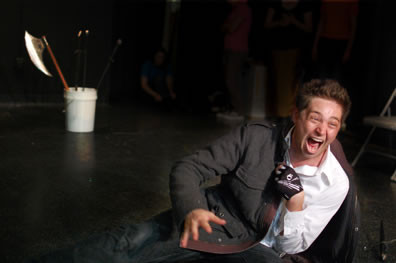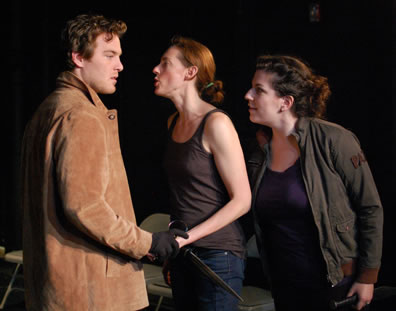Richard III
When Ten Is a Good Crowd
Brave Spirits Theatre, Atlas Performing Arts Center Lab Theatre I, Washington, D.C.
Saturday, June 23, 2012, center front
Directed by Charlene V. Smith

Travis Blumer plays Richard III in Brave Spirits' production of Richard III in a lab theater at the Atlas performing Arts Center. Blumer gives an energetic performance as the titular Richard, full of irony and gloating. Photo by Kevin Hollenbeck, Brave Spirits Theatre.
Like a motel diner or a hole-in-the-wall café, where the caring cook serves up simple but delicious fare, there are theaters off the beaten Broadway paths serving up simply delightful performances with no budget, no public acclaim, and no lines at the door. Call it sidestreet Shakespeare, such productions as that of Brave Spirits’ Richard III, where you can discover clarity of vision and superb talent flourishing under the mainstream radar.
This Richard III was presented in a small studio room with a total of 45 chairs arranged in two rows on each of three sides of a playing space. No set, no lighting, just some swords and knives stuck in white buckets at the back of the space, a snare drum on a table behind us, and a real body bag for Henry VI being the only props.
Director Charlene V. Smith, one of Brave Spirits cofounders (Victoria Reinsel, who is in the cast, being the other), notes that this early play of Shakespeare’s is a young man’s play. Richard III was 32 when he died and, historically, 19 when the play starts (Shakespeare, of course, conflates the time in the play, so Richard seems in his late 20s, at least). Shakespeare himself was in his late 20s when he wrote the play, and though his poetic genius and allegorical expertise were beginning to take root, this is still a rambunctious, not-so-subtle piece of work, such as the heavy-handed irony of Margaret’s curses so obviously coming true and Hasting’s gullibility so obviously doing him in.
The players, therefore, imbue many of their characters with almost unbridled youthful energy, rushing into their emotions and actions with little regard for consequences (George Grant's Buckingham is the lone stoic presence in the court). Jim Gagne’s Hastings is more gullible than most portrayals of this character. He pranks around with the young princes and virtually dances on the graves of Rivers and Grey just minutes before his own head is severed from his body. When the Bishop of Ely returns to the council with a basket of strawberries Richard had requested, Gagne’s Hastings snatches one and bites into it as he gleefully comments on the good mood of the temporarily absent Richard, saying, “I think there’s never a man in Christendom can lesser hide his love or hate than he.” It’s a “he didn’t do that, did he?” moment for the audience, as we already know Richard plans to have Hastings killed.
Smith further captures the play’s rambunctiousness with a constant movement of cast members and scenes crowding one upon the other. She keeps 42 of the play’s 52 speaking parts, and proportions them out to her company of 10 actors. Most of the jeans-clad players tackle five roles each, returning from one scene to the next in a different coat or gown to play a different person—yet, thanks to Shakespeare’s own clear methods of identifying people, it doesn’t confuse. Reinsel, for example, plays Lady Anne, Rivers, the young Duke of York, Blunt, and Sir John. Don’t remember Sir John? He’s the priest Hastings meets in the street on his way to the council meeting, a scene most directors cut. Smith keeps the play mostly intact (the only scene notably missing is II.2 with the Duchess of York and Clarence’s two children), trimming lines and moving at a fast pace to get the play down to just over two hours.
Do the math on Reinsel’s parts and you will figure out that Richard murdered three of her characters. In the haunting scene, all the actors—save for the sleeping Richard and Richmond—appear in masks and jointly play the ghosts’ lines like a Greek chorus, leaving only individual identification to individual actors. Reinsel thus delivers three “Think on… ” lines in three distinct voices. This economy, on paper, may sound insufficient, but it is the most beautifully effective haunting I’ve ever seen, an example of how a visionary director and a cast playing in precise unison of voice and movement can do so much more with less.
One of the production’s other singular moments has nothing to do with economy, and everything to do with interpretation. First and Second Murderers, played respectively by Rachel Hynes and Bess Kaye, approach the sleeping Clarence (Jenna Berk) like Laurel and Hardy sneaking up on a pie. Their banter is played purely for fun, and despite the gravity of the moment, they earn their laughs from the script Shakespeare has given them. This production also gave Brakenbury more meaningful substance, as Jack Powers plays him with sympathy and friendly caring for Clarence.
We enter the theater to find coats scattered around the floor and a gold diadem in the middle. Singing Blind Lemon Jefferson’s blues number “See That My Grave Is Kept Clean” as an aching Irish folk song, the actors one by one pick up the coats. Jessica Lefkow carries out the crown, and watching, longingly, as it passes by him is Travis Blumer. Only when he’s left alone does his gloved hand emerge from his coat and he stoops over to reveal his hunchback.
Blumer gives an energetic performance as the titular Richard, full of irony and gloating. A key reading comes in his opening speech when on the line “in this weak piping time of peace” he vocally clutches the last word and catapults it from his mouth; this Richard loathes peace—conflict is his fuel. It drives him through to his coronation, but it was bound to undo him once he gains the throne. Immediately upon placing the crown upon his head, Blumer’s Richard begins a precipitous descent into unhinged behavior. In Brave Spirits' staging, Richmond’s army shows discipline and bonhomie while Richard’s followers are confused and cowed.

Brakenbury (Jack Powers), lefts, confronts the two murders, played by, from left, Rachel Hynes and Bess Kaye, who have come to kill Clarence in the Brave Spirits' production of Richard III. The two murders behaved more like Laurel Hardy in this scene than bloodthirsty killers. Photo by Kevin Hollenbeck, Brave Spirits Theatre.
Richard is most interesting when he’s interacting with the women in the play. In his wooing of Lady Anne he makes a sexual play almost from the start, lips hovering millimeters from hers, and Reinsel’s Anne may be disgusted but also seems mesmerized by this affront. After Richard feints down different paths of behavior, he discovers self-pity to have the greatest effect on her, and she ends up being wood by her own seeming power over him. Similarly, he holds a semisexual hold on Kaye’s Queen Elizabeth, even kissing her on the mouth as he seeks the marriage with her daughter. Kaye’s Elizabeth, who plays this scene in emotional anger rather than as a psychological/political dance, seems to give into him (a reading I feel is contrary to Richard’s otherwise slippery grip on people in the play’s second half). Hynes makes the Duchess of York a proud martyr, always trying to out-woe the other women. Richard himself provides the keenest insight into this character when, in their last meeting, he says, “Madam, I have a touch of your condition, that cannot brook the accent of reproof,” an observation Hynes manifests in her portrayal.
Then there’s Margaret. Taken in isolation, the Margaret in Richard III seems a superfluous conflict-mongering crazy lady to many directors, but when you see the three Henry VI plays, you know the she-wolf of France was such a powerful force (and popular character) that Shakespeare brought her back unhistorically for this sequel. Lefkow as Margaret, in shredded leather long coat, is the production’s most commanding presence, venomously striking with her curses in a clarity and power that makes your hair tingle. By the time she is goading the other widows by comparing her own losses to theirs, she demands our sympathy, and we, cowed, grant it her. Lefkow also plays a most regal King Edward IV and finishes up the play as Richmond, a prince we are confident will lead the realm out of Richard’s chaos. Lefkow’s fourfold performance (she also plays the Archbishop of York) is reason alone to take in this production. Another standout set of performances comes from Powers who, along with Brakenbury, plays Prince Edward as a young teen uncomfortably wearing the mantle of new king, and Catesby as a loyal lieutenant who hitches his career to the wrong man but stays true until the end when Richard’s abuse of him becomes too overbearing.
Everybody in this most capable cast is proof that good actors don’t all fly to the big lights up the coast or can’t be found on any but the big stages downtown. Here they give their all in a small, bare space in the service of Shakespeare, unencumbered by a big-budget set, guided by a director with a vision as keen and a hand as sure as any in the business.
Eric Minton
June 25, 2012
This review also appears on PlayShakespeare.com
Comment: e-mail editorial@shakespeareances.com
Start a discussion in the Bardroom



 Find additional Shakespeareances
Find additional Shakespeareances